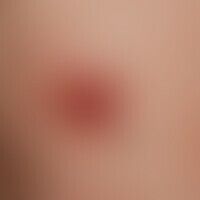Image diagnoses for "Nodule (<1cm)"
268 results with 997 images
Results forNodule (<1cm)

Fibroxanthoma atypical C49; D48.1
Fibroxanthoma atpyisches: flat ulcerated lump in a man (84 years), clearly visible in actinically damaged skin.

Squamous cell carcinoma of the skin C44.-
Squamous cell carcinoma of the skin: ulcerated, spinocellular carcinoma of the lower leg, which has long been misunderstood as an ulcer (cruris) and thus has been treated unsuccessfully. Remarkable: Only slight pain!

Lymphomatoids papulose C86.6
lymphomatoid papulosis: previously known recurrent clinical picture in a 34-year-old female patient. rapid, painless knot formation within 14 days. this finding healed spontaneously with scarring under central necrosis after 3 months. no ectropion!

Facial granuloma L92.2
facial granuloma: red lump, existing for 5 years now, slowly progressing in size and limited in size. small secondary plaques in the surrounding area. histological findings characterized by increasing fibrosis. findings 2 years later (see initial findings in fig., before). treatment with fast electrons. after that clear regression. no further progression. note smooth surface relief. no follicle drawing.

Keloid (overview) L91.0
Keloid node. Chronic stationary clinical picture. Gigantic keloid node due to repeated ritual injuries to the earlobe.

Melanoma nodular C43.L
Melanoma, malignant, nodular: Rapid growth in thickness in the last few months "I have already wet and bled once" (see further explanation in the following figure)

Vascular malformations Q28.88
Malformation, vascular: venousmalformation with circumscribed, painless soft tissue swelling (circled); ectatic subcutaneous veins.

Melanoma amelanotic C43.L
Melanoma, malignant, amelanotic. Incident light microscopy. Largely melanin-free parenchyma. Marginal delicate pigmentation, dense in the middle.

Merkel cell carcinoma C44.L
Merkel cell carcinoma. solitary, fast growing, asymptomatic, bright red, coarse, shifting, smooth lump with atrophic surface. the appearance in the area of UV-exposed sites is typical.

Carcinoma cuniculatum C44.L5
Carcinoma cuniculatum: Advanced verrucous carcinoma of the sole of the foot (here heel region), which has existed in its early stages for >2 years. No significant pain symptoms. No regional lymph node metastases detectable.

Acuminate condyloma A63.0
Condylomata acuminata, finding in an infant with multiple small papules with few symptoms.

Calcinosis cutis (overview) L94.2
Calcinosis cutis dystrophica: centrally ulcerated nodule with visible calcification of the auricle.

Squamous cell carcinoma of the skin C44.-
Ulcerated squamous cell carcinoma: cauliflower-like, firm, less pain-sensitive, eroded and ulcerated, weeping nodule, which has been present for > 1 year and is constantly enlarging.

Lipoma (overview) D17.0
Naevus lipomatosus cutaneus superficialis: Lipomasof the skin with soft protuberant papules and nodules.

Melanoma amelanotic C43.L
Melanoma malignes, amelanotic: a reddish lump that has existed for years, which has been constantly weeping and bleeding for several months.

Keratosis seborrhoic (papillomatous type) L82
Seborrhoeic keratosis in different stages of development: Papules marked with arrows, plaques encircled, nodes marked rectangularly.

Skin metastases C79.8

Cutaneous t-cell lymphomas C84.8
lymphoma, cutaneous t-cell lymphoma. type mycosis fungoides, tumor stage. painless, scaly, partly crusty plaque existing for years with slow knot formation and increasing growth rate. moderately firm consistency. extensive crust formation.

Leprosy lepromatosa A30.50
Leprosy lepromatosa: Boderline type of leprosy lepromatosa; inflammatory type I reaction (leprosy reaction) in the existing leprosy herds.





